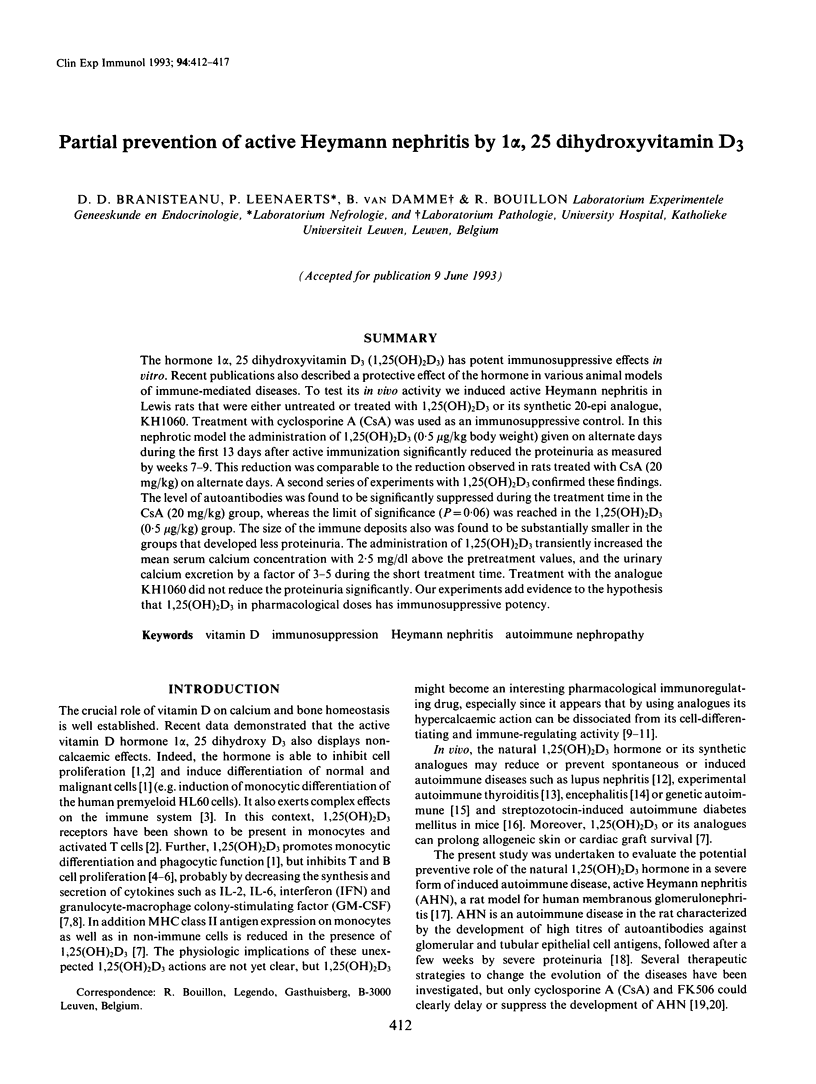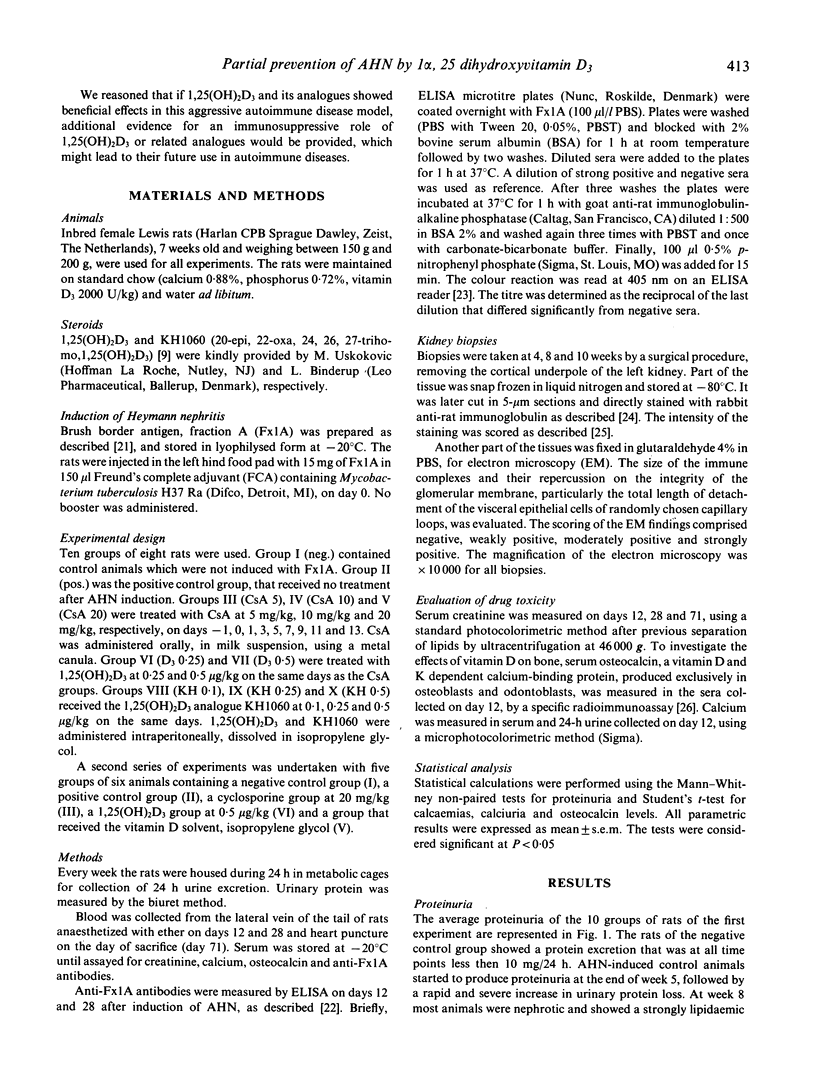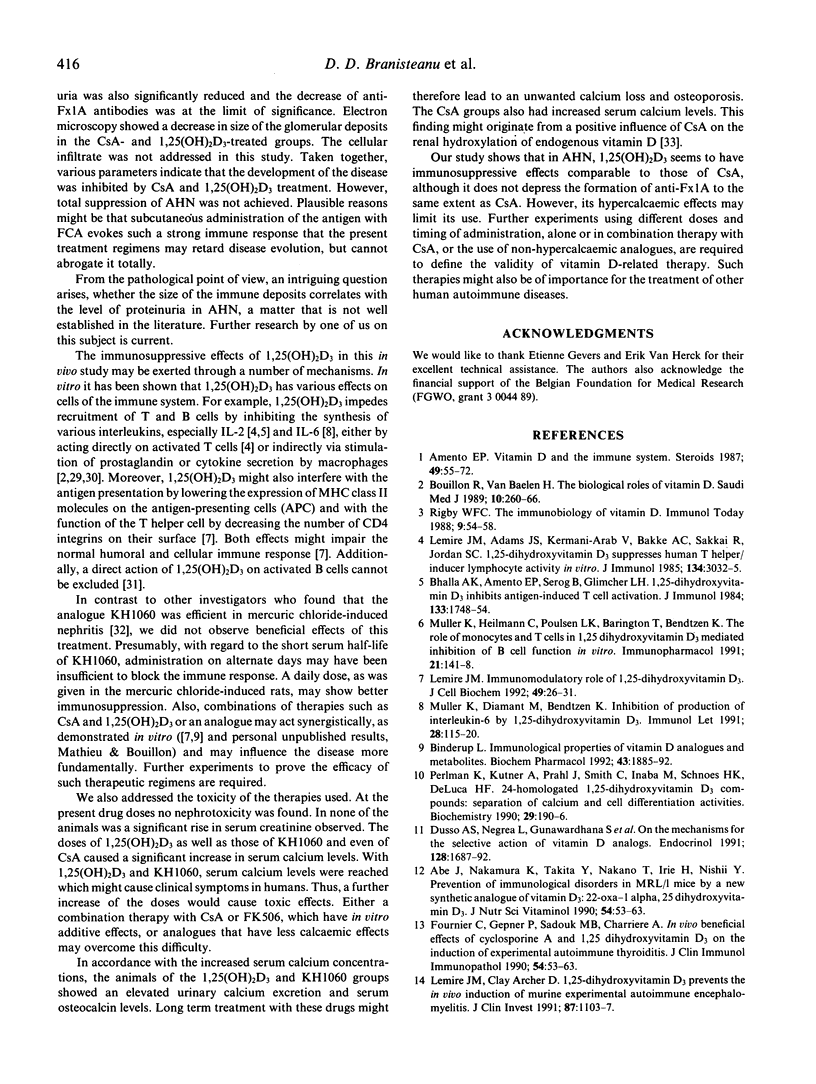Abstract
The hormone 1 alpha, 25 dihydroxyvitamin D3 (1,25(OH)2D3) has potent immunosuppressive effects in vitro. Recent publications also described a protective effect of the hormone in various animal models of immune-mediated diseases. To test its in vivo activity we induced active Heymann nephritis in Lewis rats that were either untreated or treated with 1,25(OH)2D3 or its synthetic 20-epi analogue, KH1060. Treatment with cyclosporine A (CsA) was used as an immunosuppressive control. In this nephrotic model the administration of 1,25(OH)2D3 (0.5 microgram/kg body weight) given on alternate days during the first 13 days after active immunization significantly reduced the proteinuria as measured by weeks 7-9. This reduction was comparable to the reduction observed in rats treated with CsA (20 mg/kg) on alternate days. A second series of experiments with 1,25(OH)2D3 confirmed these findings. The level of autoantibodies was found to be significantly suppressed during the treatment time in the CsA (20 mg/kg) group, whereas the limit of significance (P = 0.06) was reached in the 1,25(OH)2D3 (0.5 microgram/kg) group. The size of the immune deposits also was found to be substantially smaller in the groups that developed less proteinuria. The administration of 1,25(OH)2D3 transiently increased the mean serum calcium concentration with 2.5 mg/dl above the pretreatment values, and the urinary calcium excretion by a factor of 3-5 during the short treatment time. Treatment with the analogue KH1060 did not reduce the proteinuria significantly. Our experiments add evidence to the hypothesis that 1,25(OH)2D3 in pharmacological doses has immunosuppressive potency.
Full text
PDF





Images in this article
Selected References
These references are in PubMed. This may not be the complete list of references from this article.
- Amento E. P. Vitamin D and the immune system. Steroids. 1987 Jan-Mar;49(1-3):55–72. doi: 10.1016/0039-128x(87)90079-1. [DOI] [PubMed] [Google Scholar]
- Bhalla A. K., Amento E. P., Serog B., Glimcher L. H. 1,25-Dihydroxyvitamin D3 inhibits antigen-induced T cell activation. J Immunol. 1984 Oct;133(4):1748–1754. [PubMed] [Google Scholar]
- Binderup L. Immunological properties of vitamin D analogues and metabolites. Biochem Pharmacol. 1992 May 8;43(9):1885–1892. doi: 10.1016/0006-2952(92)90630-2. [DOI] [PubMed] [Google Scholar]
- Blifeld C., Prehn J. L., Jordan S. C. Stimulus-specific 1,25(OH)2D3 modulation of TNF and IL-1-beta gene expression in human peripheral blood mononuclear cells and monocytoid cell lines. Transplantation. 1991 Feb;51(2):498–503. doi: 10.1097/00007890-199102000-00043. [DOI] [PubMed] [Google Scholar]
- Cheng I. K., Dorsch S. E., Hall B. M. Lymphocyte subsets in Heymann nephritis. Lab Invest. 1984 Sep;51(3):286–291. [PubMed] [Google Scholar]
- Cheng I. K., Dorsch S. E., Hall B. M. The regulation of autoantibody production in Heymann's nephritis by T lymphocyte subsets. Lab Invest. 1988 Dec;59(6):780–788. [PubMed] [Google Scholar]
- Dusso A. S., Negrea L., Gunawardhana S., Lopez-Hilker S., Finch J., Mori T., Nishii Y., Slatopolsky E., Brown A. J. On the mechanisms for the selective action of vitamin D analogs. Endocrinology. 1991 Apr;128(4):1687–1692. doi: 10.1210/endo-128-4-1687. [DOI] [PubMed] [Google Scholar]
- Edgington T. S., Glassock R. J., Dixon F. J. Autologous immune complex nephritis induced with renal tubular antigen. I. Identification and isolation of the pathogenetic antigen. J Exp Med. 1968 Mar 1;127(3):555–572. doi: 10.1084/jem.127.3.555. [DOI] [PMC free article] [PubMed] [Google Scholar]
- Fournier C., Gepner P., Sadouk M., Charreire J. In vivo beneficial effects of cyclosporin A and 1,25-dihydroxyvitamin D3 on the induction of experimental autoimmune thyroiditis. Clin Immunol Immunopathol. 1990 Jan;54(1):53–63. doi: 10.1016/0090-1229(90)90005-b. [DOI] [PubMed] [Google Scholar]
- Grönhagen-Riska C., von Willebrand E., Tikkanen T., Honkanen E., Miettinen A., Holthöfer H., Törnroth T. The effect of cyclosporin A on the interstitial mononuclear cell infiltration and the induction of Heymann's nephritis. Clin Exp Immunol. 1990 Feb;79(2):266–272. doi: 10.1111/j.1365-2249.1990.tb05189.x. [DOI] [PMC free article] [PubMed] [Google Scholar]
- HEYMANN W., HACKEL D. B., HARWOOD S., WILSON S. G., HUNTER J. L. Production of nephrotic syndrome in rats by Freund's adjuvants and rat kidney suspensions. Proc Soc Exp Biol Med. 1959 Apr;100(4):660–664. doi: 10.3181/00379727-100-24736. [DOI] [PubMed] [Google Scholar]
- Hara M., Batsford S. R., Mihatsch M. J., Bitter-Suermann D., Vogt A. Complement and monocytes are essential for provoking glomerular injury in passive Heymann nephritis in rats. Terminal complement components are not the sole mediators of proteinuria. Lab Invest. 1991 Aug;65(2):168–179. [PubMed] [Google Scholar]
- Inaba M., Nishizawa Y., Song K., Tanishita H., Okuno S., Miki T., Morii H. Partial protection of 1 alpha-hydroxyvitamin D3 against the development of diabetes induced by multiple low-dose streptozotocin injection in CD-1 mice. Metabolism. 1992 Jun;41(6):631–635. doi: 10.1016/0026-0495(92)90055-f. [DOI] [PubMed] [Google Scholar]
- Lemire J. M., Adams J. S., Kermani-Arab V., Bakke A. C., Sakai R., Jordan S. C. 1,25-Dihydroxyvitamin D3 suppresses human T helper/inducer lymphocyte activity in vitro. J Immunol. 1985 May;134(5):3032–3035. [PubMed] [Google Scholar]
- Lemire J. M., Archer D. C. 1,25-dihydroxyvitamin D3 prevents the in vivo induction of murine experimental autoimmune encephalomyelitis. J Clin Invest. 1991 Mar;87(3):1103–1107. doi: 10.1172/JCI115072. [DOI] [PMC free article] [PubMed] [Google Scholar]
- Lemire J. M. Immunomodulatory role of 1,25-dihydroxyvitamin D3. J Cell Biochem. 1992 May;49(1):26–31. doi: 10.1002/jcb.240490106. [DOI] [PubMed] [Google Scholar]
- Lillevang S. T., Rosenkvist J., Andersen C. B., Larsen S., Kemp E., Kristensen T. Single and combined effects of the vitamin D analogue KH1060 and cyclosporin A on mercuric-chloride-induced autoimmune disease in the BN rat. Clin Exp Immunol. 1992 May;88(2):301–306. doi: 10.1111/j.1365-2249.1992.tb03077.x. [DOI] [PMC free article] [PubMed] [Google Scholar]
- Mathieu C., Laureys J., Sobis H., Vandeputte M., Waer M., Bouillon R. 1,25-Dihydroxyvitamin D3 prevents insulitis in NOD mice. Diabetes. 1992 Nov;41(11):1491–1495. doi: 10.2337/diab.41.11.1491. [DOI] [PubMed] [Google Scholar]
- Matsukawa W., Hara S., Yoshida F., Suzuki N., Fukatsu A., Yuzawa Y., Sakamoto N., Matsuo S. Effects of a new immunosuppressive agent, FK506, in rats with active Heymann nephritis. J Lab Clin Med. 1992 Feb;119(2):116–123. [PubMed] [Google Scholar]
- Müller K., Diamant M., Bendtzen K. Inhibition of production and function of interleukin-6 by 1,25-dihydroxyvitamin D3. Immunol Lett. 1991 May;28(2):115–120. doi: 10.1016/0165-2478(91)90108-m. [DOI] [PubMed] [Google Scholar]
- Perlman K., Kutner A., Prahl J., Smith C., Inaba M., Schnoes H. K., DeLuca H. F. 24-homologated 1,25-dihydroxyvitamin D3 compounds: separation of calcium and cell differentiation activities. Biochemistry. 1990 Jan 9;29(1):190–196. doi: 10.1021/bi00453a026. [DOI] [PubMed] [Google Scholar]
- Provvedini D. M., Tsoukas C. D., Deftos L. J., Manolagas S. C. 1 alpha,25-Dihydroxyvitamin D3-binding macromolecules in human B lymphocytes: effects on immunoglobulin production. J Immunol. 1986 Apr 15;136(8):2734–2740. [PubMed] [Google Scholar]
- Quigg R. J. Glomerular injury induced by antibody and complement. Semin Nephrol. 1991 May;11(3):259–267. [PubMed] [Google Scholar]
- Quiza C. G., Leenaerts P. L., Hall B. M. Induction of unresponsiveness to Heymann's nephritis: inhibited by monoclonal antibody to CD4 but not to CD8. Cell Immunol. 1991 Apr 1;133(2):456–467. doi: 10.1016/0008-8749(91)90118-u. [DOI] [PubMed] [Google Scholar]
- Quiza C. G., Leenaerts P. L., Hall B. M. The role of T cells in the mediation of glomerular injury in Heymann's nephritis in the rat. Int Immunol. 1992 Apr;4(4):423–432. doi: 10.1093/intimm/4.4.423. [DOI] [PubMed] [Google Scholar]
- Rigby W. F. The immunobiology of vitamin D. Immunol Today. 1988 Feb;9(2):54–58. [PubMed] [Google Scholar]
- Salant D. J., Quigg R. J., Cybulsky A. V. Heymann nephritis: mechanisms of renal injury. Kidney Int. 1989 Apr;35(4):976–984. doi: 10.1038/ki.1989.81. [DOI] [PubMed] [Google Scholar]
- Stein B., Halloran B. P., Reinhardt T., Engstrom G. W., Bales C. W., Drezner M. K., Currie K. L., Takizawa M., Adams J. S., Epstein S. Cyclosporin-A increases synthesis of 1,25-dihydroxyvitamin D3 in the rat and mouse. Endocrinology. 1991 Mar;128(3):1369–1373. doi: 10.1210/endo-128-3-1369. [DOI] [PubMed] [Google Scholar]
- Verhaeghe J., Van Herck E., Van Bree R., Van Assche F. A., Bouillon R. Osteocalcin during the reproductive cycle in normal and diabetic rats. J Endocrinol. 1989 Jan;120(1):143–151. doi: 10.1677/joe.0.1200143. [DOI] [PubMed] [Google Scholar]
- Zarrabeitia M. T., Riancho J. A., Amado J. A., Olmos J. M., Gonzalez-Macias J. Effect of calcitriol on the secretion of prostaglandin E2, interleukin 1, and tumor necrosis factor alpha by human monocytes. Bone. 1992;13(2):185–189. doi: 10.1016/8756-3282(92)90010-t. [DOI] [PubMed] [Google Scholar]



